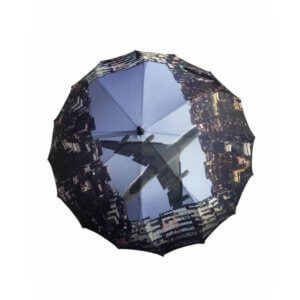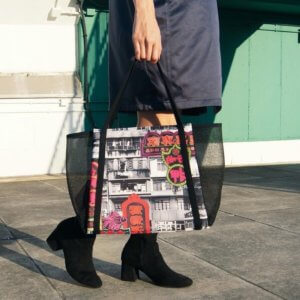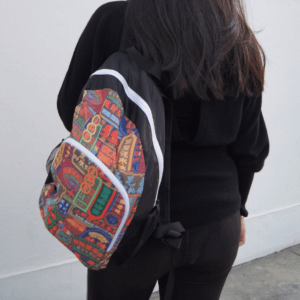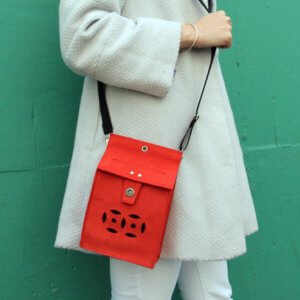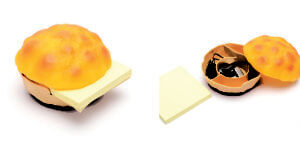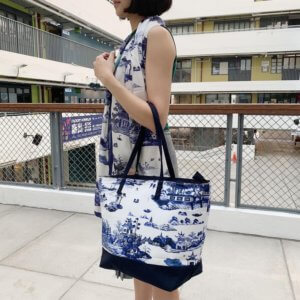Urban Explorer Series: Douglas's Travel Itinerary
“As a very proud Hong Kong brand, we feel that we are partly responsible for updating our many local traditions and making it relevant to consumers today. Our designs aim to draw inspiration from everyday life of the city, especially from the traditional districts, and we try to add a bit of modern funk into it so that people can wear it and implement it into their daily lives.”
Douglas’s Hong Kong Travel Itinerary
[MAP] [DOWNLOAD]
Our Urban Explorer of the moment, Mr. Douglas Young, is one-half of the visionary entrepreneurs of Hong Kong lifestyle brand Goods of Desire, also known as G.O.D. (if spoken in Cantonese, it means “Live Better”). Known for its tongue in cheek interpretation of Hong Kong design and culture, the brand playfully re-tells Chinese traditions that are visible throughout the city in a modern way. With this in mind, we asked Douglas to fill us in on which parts of Hong Kong he draws inspiration from for his fun and comical designs found in the G.O.D. stores. Through the brand’s designs, Page Hotels has created an itinerary of iconic places within the city that is truly worth visiting:
Yik Cheong Building: The print seen here is an amalgamation of Kai Tak Airport (now renamed the Kai Tak Cruise Terminal) in Kwun Tong and Yik Cheong building in Quarry Bay (also known as “Monster Building” for its conglomeration of five incredibly dense and stacked residential complexes). The print of the airplane flying over the concrete jungle that is Hong Kong in the ‘Aeroplane’ long umbrella reveals how densely populated the city is, particularly in this compact residential area. In recent years, this place in Quarry Bay has become the ideal location for filming big blockbuster hits like “Transformers: Age of Extinction” and “Ghost in the Shell”. This iconic destination is a very accurate representation of Hong Kong’s density and definitely worth visiting.
Yau Ma Tei: Combining two of G.O.D.’s most popular prints, the brand has tattooed ‘Nathan Road’ onto ‘Yaumati’ in this one-of-a-kind ‘Yaumati Tattoo’ tote bag. This print has the iconic neon light shop signs sitting atop a black and white photo of the old tenement buildings (tong lau), highlighting two distinct parts of our culture which are sadly disappearing as Hong Kong modernises. The old historical buildings in this district as well as some of its renowned attractions like Tin Hau Temple and Temple Street will give you a glimpse of the city’s authentic local culture.
Lan Kwai Fong: The ‘Lan Kwai Fong’ mini cushion celebrates the lively district of Lan Kwai Fong in Central that consists of a few streets in Hong Kong’s Central district, forming a rectangle that was previously used by hawkers before World War II. Surrounded by office buildings and swanky skyscrapers, this business zone is home to some of the best bars, clubs and restaurants in Hong Kong. Be sure to visit Hong Kong’s premier bar and nightlife district at some point during your visit.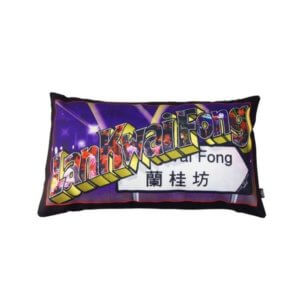 Nathan Road in Kowloon: The ‘Nathan Road’ foldable backpack pays homage to the iconic Hong Kong urban scene inspired by the lit up neon signs that used to populate Nathan Road in Tsim Sha Tsui. Also referred to as the ‘Golden Mile’, Nathan Road stretches out from Victoria Harbour and behind the famous Peninsula Hotel and takes you through the glamorous attractions of Tsim Sha Tsui and beyond into the more local shopping area of Jordan and Yau Ma Tei.
Nathan Road in Kowloon: The ‘Nathan Road’ foldable backpack pays homage to the iconic Hong Kong urban scene inspired by the lit up neon signs that used to populate Nathan Road in Tsim Sha Tsui. Also referred to as the ‘Golden Mile’, Nathan Road stretches out from Victoria Harbour and behind the famous Peninsula Hotel and takes you through the glamorous attractions of Tsim Sha Tsui and beyond into the more local shopping area of Jordan and Yau Ma Tei.
Hollywood Road in Central: This cushion cover beautifully displays the ‘Alex Croft x G.O.D.’ graffiti wall that is located on Graham Street next to the Goods of Desire store on Hollywood Road in Central district. The mural by Hong Kong-based graffiti artist, Alex Croft, was inspired by G.O.D.’s signature print, ‘Yaumati’ and is an illustrated interpretation of old Hong Kong tenement buildings. This vibrant mural situated right on Hollywood Road is one of the most captured hotspots on Instagram, so you will definitely want to add this to your itinerary. After your mini photo shoot, go for a casual drink at one of the nearby bars before hitting up one of the many hip and trendy restaurants in the area.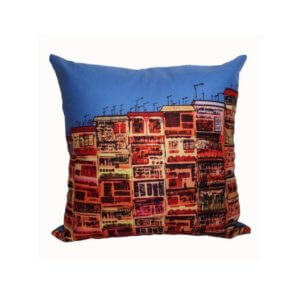 Kai Tak Cruise Terminal: The ‘Kai Tak International Airport’ luggage tag you see here was inspired by the days before the current Chep Lap Kok (Hong Kong’s international airport) was Kai Tak Cruise Terminal. With looming skyscrapers and mountains to the north and its lone runway sticking out into the harbour, landings at the airport were dramatic for both pilots and passengers. Relive Hong Kong’s ancient past by stopping by this iconic landmark.
Kai Tak Cruise Terminal: The ‘Kai Tak International Airport’ luggage tag you see here was inspired by the days before the current Chep Lap Kok (Hong Kong’s international airport) was Kai Tak Cruise Terminal. With looming skyscrapers and mountains to the north and its lone runway sticking out into the harbour, landings at the airport were dramatic for both pilots and passengers. Relive Hong Kong’s ancient past by stopping by this iconic landmark.
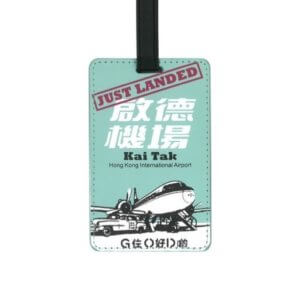 Sheung Wan: This leather ‘Letterbox’ bag is inspired by the colourful metal letterboxes that were scattered throughout the hallways in older Hong Kong buildings; each box is painted and marked in distinctive colours to be easily identified by its owner. They are getting more difficult to find, but if you look hard enough in the more historical areas of the city like Sheung Wan, you are bound to find this unique piece of iconography only in Hong Kong.
Sheung Wan: This leather ‘Letterbox’ bag is inspired by the colourful metal letterboxes that were scattered throughout the hallways in older Hong Kong buildings; each box is painted and marked in distinctive colours to be easily identified by its owner. They are getting more difficult to find, but if you look hard enough in the more historical areas of the city like Sheung Wan, you are bound to find this unique piece of iconography only in Hong Kong.
Mong Kok Street Markets: The ‘Lucky Cat Armour’ icon printed on this mini tote is evidently a Lucky Cat, one of Asia’s most loved symbols that is said to attract good luck, wealth and prosperity. It can usually be found with its upright paw in the front of shops and restaurants. The intricate traditional armour background pattern will guard one against bad qi (energy). Be sure to explore the Mong Kok street markets to find these iconic Lucky Cat statues solde at some of the street stalls and local shops. Whether you are meandering Fa Yuen Street Market – in which you can find everything from clothing apparel and undergarments to mobile and laptop accessories – or sifting through piles of fashion knock-offs, handbags and watches in Ladies Market, you will surely find some eclectic souvenirs for you to take home with you on your journey.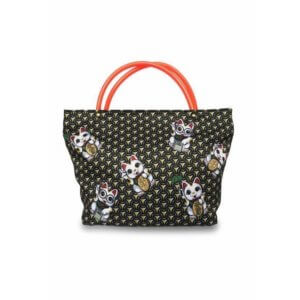
Sai Kung Café & Bakery: There is really nothing like a good pineapple bun to start your day! In this humorous memo pad, G.O.D. pays homage to the classic staple breakfast item of Hong Kong, also referred to in Cantonese as “Bo Lo Bao”. It can be found in both street stalls and restaurants – each institution with its own interpretation. The body of the bun is soft and airy as it comes straight out of the oven and topped with a sweet, crunchy crust. Though there is no pineapple inside the bun, the name originated because of its distinct, yellow crust at the top which resembles that of a pineapple. For the best classic pastry in town, head on over to Sai Kung Café & Bakery. This bakery churns out over 100 batches of pineapple buns each day – which sell out by 5pm, even on weekdays, so make sure to go earlier in the day!
Yuet Tung China Works: The ‘Willow’ tote is inspired by the long tradition of landscape painting on porcelain. Traditional scenes featuring mountains, trees and pagodas are illustrated in cobalt blue and white which were generally found on porcelain, especially vases. The beautiful artwork from Hong Kong is hard to come by nowadays. For instance, Yuet Tung China Works is the city’s first and last hand-painted porcelain factory. Located in Kowloon Bay, this factory was first established in 1928, producing “Guang Cai,” a special kind of Qing dynasty ceramic originating from Guangzhou. Its intricate design and beautiful artwork is truly an artisanal craft that should continue to be preserved. Go off the beaten track and take a walk back in time to see how this 91 years old factory has made a name for itself in not only its industry but within the community as well.
